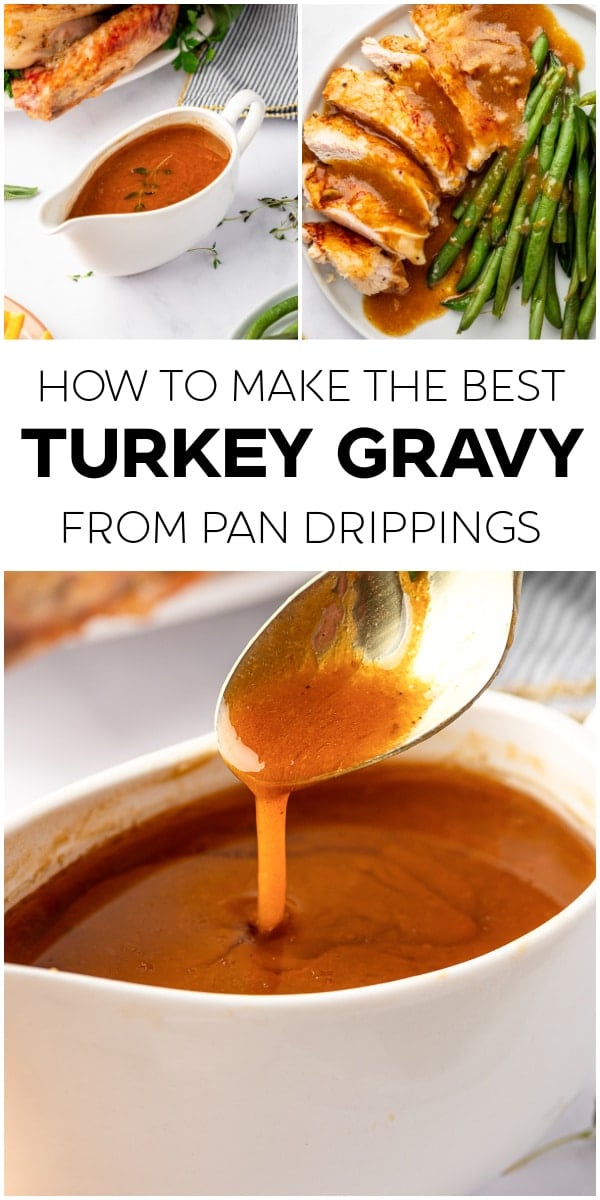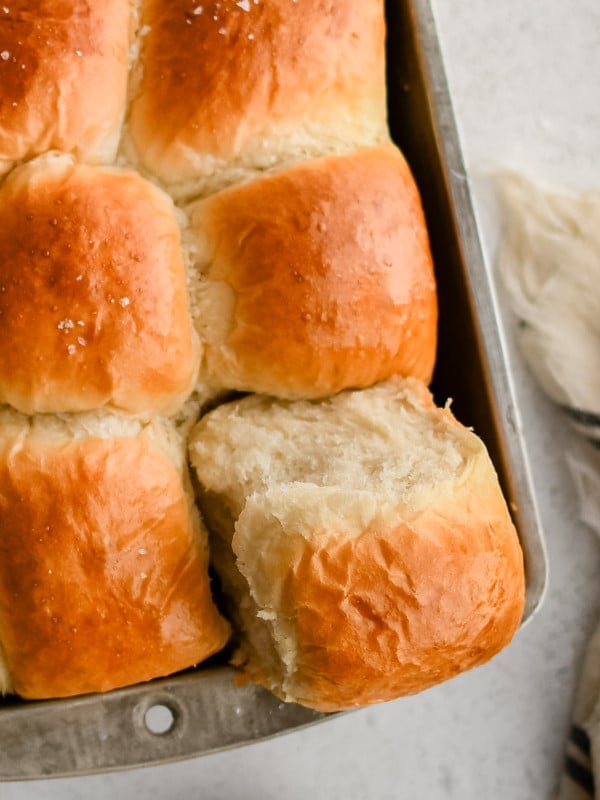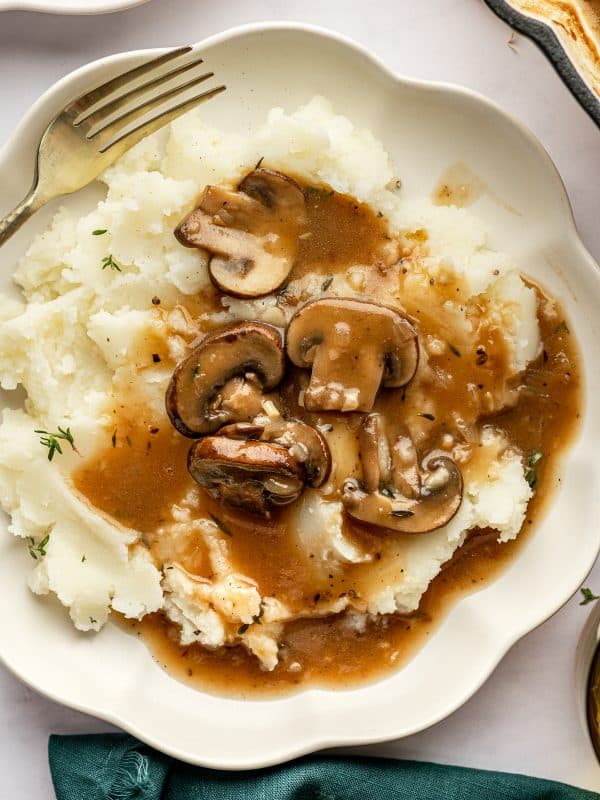This post may contain affiliate links. See my disclosure policy.
Homemade Turkey Gravy is easy to make and tastes absolutely delicious when it’s built from the pan drippings of your Thanksgiving turkey. Even if you only have a few tablespoons of pan drippings to work with, that’s all you’ll need to infuse it with the rich holiday flavor of your bird.
Ready in just 20 minutes, this gravy is fast, flavorful, and foolproof. For even more depth, you can simmer the turkey neck and giblets into a quick stock and add it in, or leave them out for a smooth, classic finish.
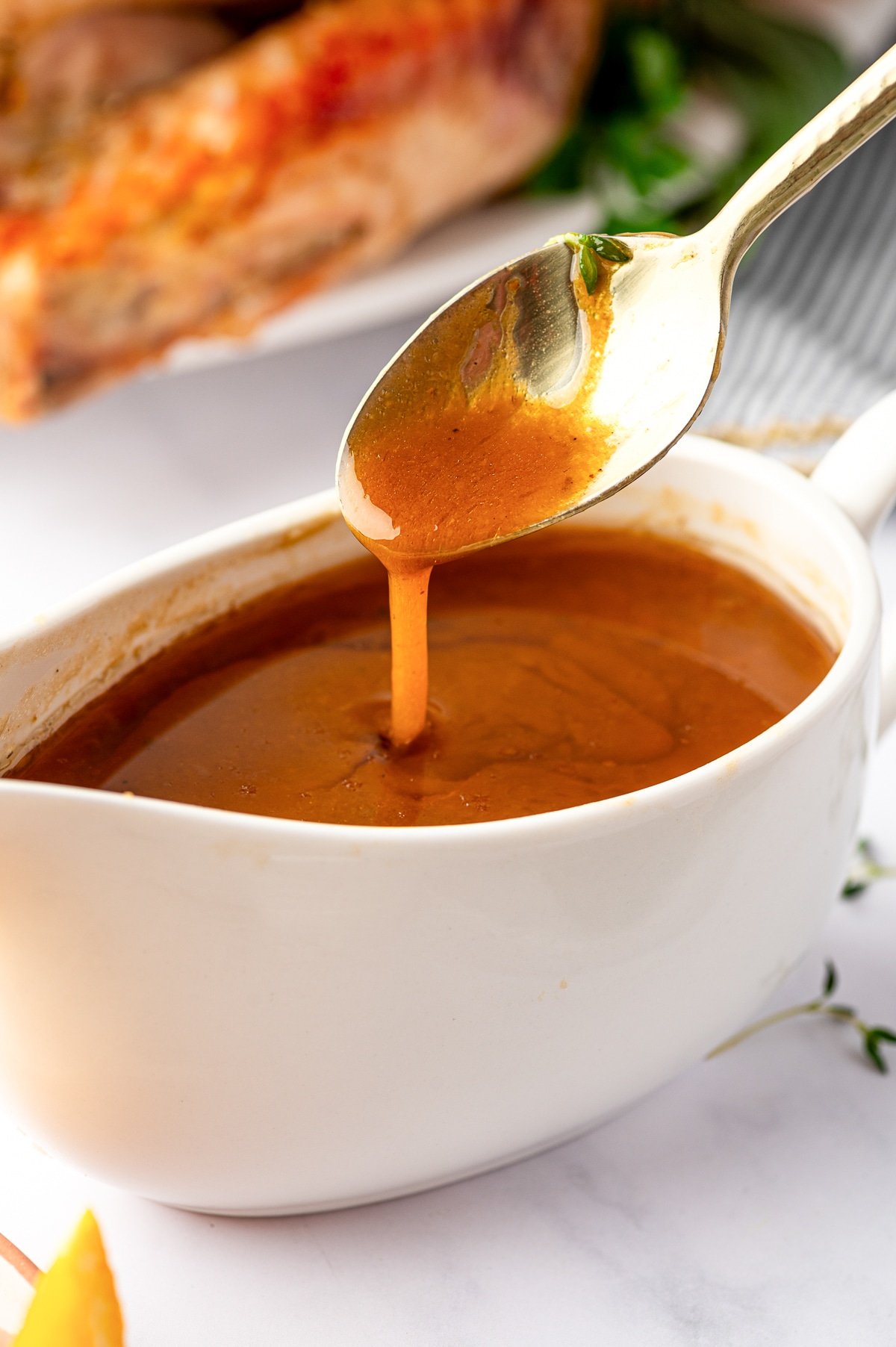
Table of Contents
- This is the Best Turkey Gravy Recipe – Here’s Why
- What it Means to Make Gravy with Roux
- Key Ingredients
- How to Make Turkey Gravy Step-By-Step
- Pro Tip: Make Extra Gravy
- Storage and Reheating Tips
- How to Keep Gravy Warm
- Turkey Gravy Frequently Asked Questions
- More Popular Thanksgiving Recipes
- Turkey Gravy Recipe (with Pan Drippings)
Making homemade turkey gravy may seem complicated, but once you understand the basics, it’s incredibly simple.
In this recipe, I’ll show you exactly how to make the most delicious gravy from real pan drippings, as well as how to prepare a quick giblet stock for those who want more classic, old-fashioned flavor or need extra gravy to feed a larger crowd.
This is the Best Turkey Gravy Recipe – Here’s Why
- It’s quick and easy. For this recipe, you’ll skim 3 to 4 tablespoons of fat from the turkey drippings and whisk it with an equal amount of flour to make a roux. Then you’ll slowly add your strained drippings and stock until the gravy reaches your ideal thickness. In just 20 minutes, you’ll have warm, velvety gravy that tastes like you spent all day on it.
- It uses what you already have. No need to spend extra money on store-bought gravy packets when you already have the most flavorful ingredient right in your roasting pan. Pan drippings are infused with all the herbs, seasoning, and browned bits from your turkey, giving the gravy incredible depth without any extra effort
- Flexible yield and taste. You don’t need drippings from a huge 15+ pound turkey to make delicious turkey gravy. Simply adjust the amount of stock or add homemade giblet stock until you’ve made enough gravy to fill everyone’s plates.
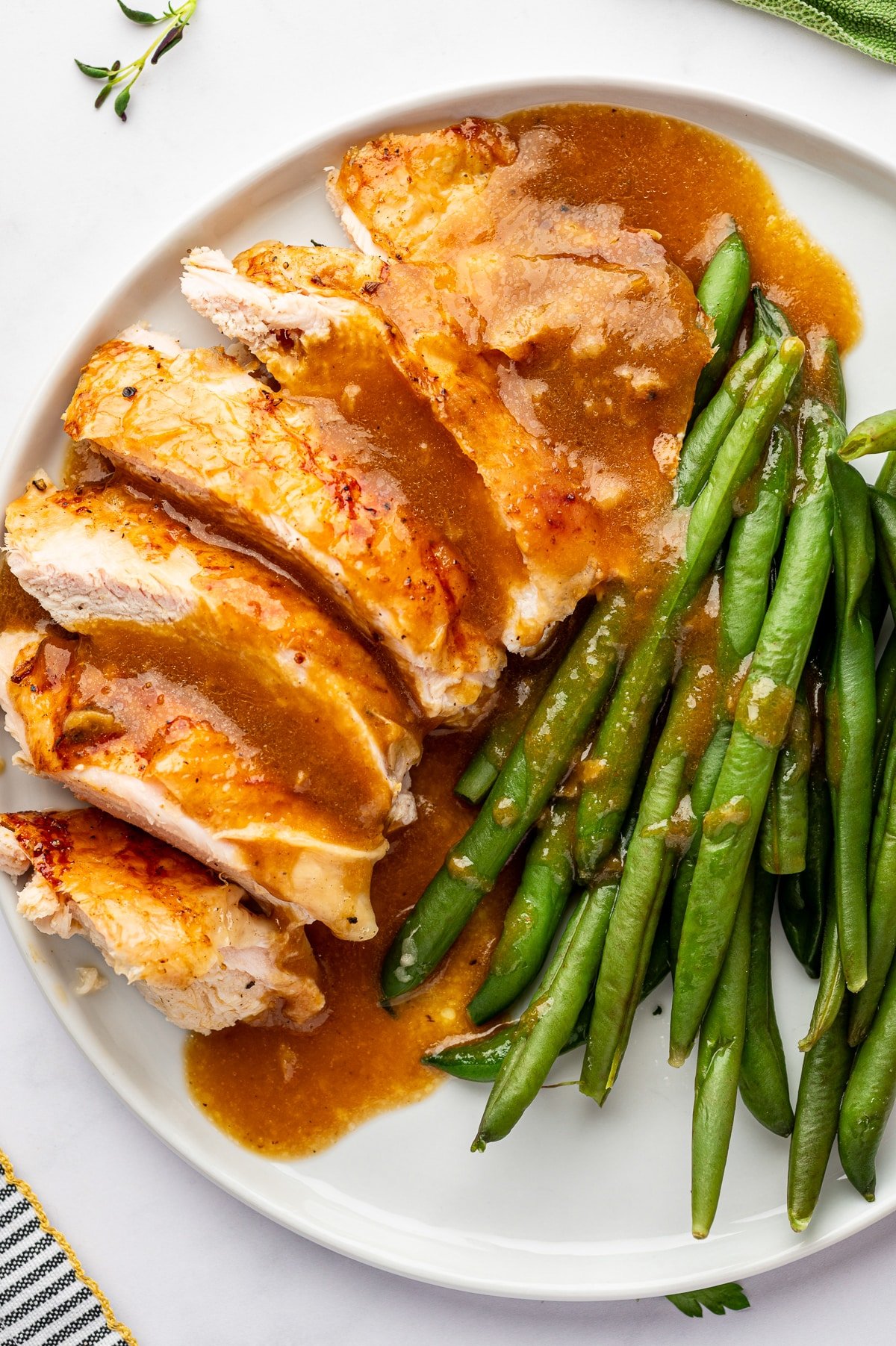
What it Means to Make Gravy with Roux
A roux is a combination of equal parts fat (such as pan drippings, butter, or oil) and flour, cooked together to thicken sauces, gravies, and soups. If this is your first time making homemade gravy with pan drippings, here’s what you should know before getting started:
- Use equal parts fat and flour. You’ll skim about 3-4 tablespoons of fat from the drippings and whisk in the same amount of flour. This 1:1 ratio ensures the gravy thickens properly and remains silky, rather than becoming gummy.
- Skim extra fat before using the drippings. The fat rises to the top as the drippings rest. Use only what you need to make the roux – too much fat in the drippings and the gravy can cause them to become oily or greasy.
- Cook the roux to remove the raw flour taste. Let it bubble and cook for 2 to 3 minutes, just until lightly golden and fragrant. It doesn’t need to turn dark; just enough time to develop a smooth, toasty flavor.
- Add liquid slowly for lump-free gravy. Pour in the strained drippings and stock a little at a time while whisking constantly. This helps the liquid incorporate evenly, resulting in a flawless texture.
- Remember that gravy thickens as it cools. When it looks slightly thinner than you want in the pan, it will thicken to the perfect spoon-coating consistency once served.
What Affects the Color of Turkey Gravy?
The shade of your gravy depends on how dark your drippings and roux become. Darker, more caramelized drippings and a roux that’s cooked for a longer time will create a deeper brown gravy with richer flavor. Gravy made from lighter drippings (like from a roast turkey breast) will naturally be more golden
Key Ingredients
Turkey gravy is built from three main ingredients:
- Pan Drippings: The flavorful juices and browned bits left in the roasting pan after cooking your turkey or turkey breast. These drippings are liquid gold and the secret to the very best turkey gravy. Even a small amount goes a long way.
- Fat: Spoon off 3 to 4 tablespoons of fat from the drippings and use that to make your roux. If you don’t have enough fat, make up the difference with butter or vegetable oil.
- Flour: All-purpose flour thickens the gravy into a smooth, velvety sauce.
Not Enough Drippings? No Problem
If you’re short on drippings (as may be the case if you’re roasting turkey breast), you can easily make a quick stock using the neck and giblets found inside the turkey cavity. Simply simmer them in a small pot of water while the turkey cooks to create a rich, flavorful broth that you can add to your gravy.
- Note: Some people find the liver adds a slightly bitter or metallic taste, so it’s best to leave it out and use only the neck, heart, and gizzard. If your turkey didn’t come with giblets or you prefer to skip them, you can use low-sodium turkey or chicken stock instead, or try my homemade Turkey Stock for even deeper flavor.

How to Make Turkey Gravy Step-By-Step
Honestly, making homemade turkey gravy is surprisingly easy once you understand the order of operations. Follow these steps below and you’ll have a silky, flavorful gravy every time.
Step 1: Simmer the giblets (optional)
As the turkey cooks, make a quick giblet stock by simmering the turkey neck and giblets (except for the liver) in a small pot of water for about 45 to 60 minutes. Strain the broth through a fine mesh strainer, reserving the liquid.
Optional: Finely chop up the cooked giblets and stir them into the finished gravy for a more old-fashioned version, or discard them for a smooth gravy.
Step 2: Collect the drippings
Once your turkey is finished roasting, carefully lift it out of the pan and tilt it slightly so any juices inside run into the roasting pan. If there’s enough drippings to coat the bottom of the roasting pan, move on to the next step.
Not enough drippings? Pour about 1 cup of low-sodium turkey broth or giblet stock into the pan and bring it to a simmer, scraping up any browned bits (fond) stuck to the bottom.
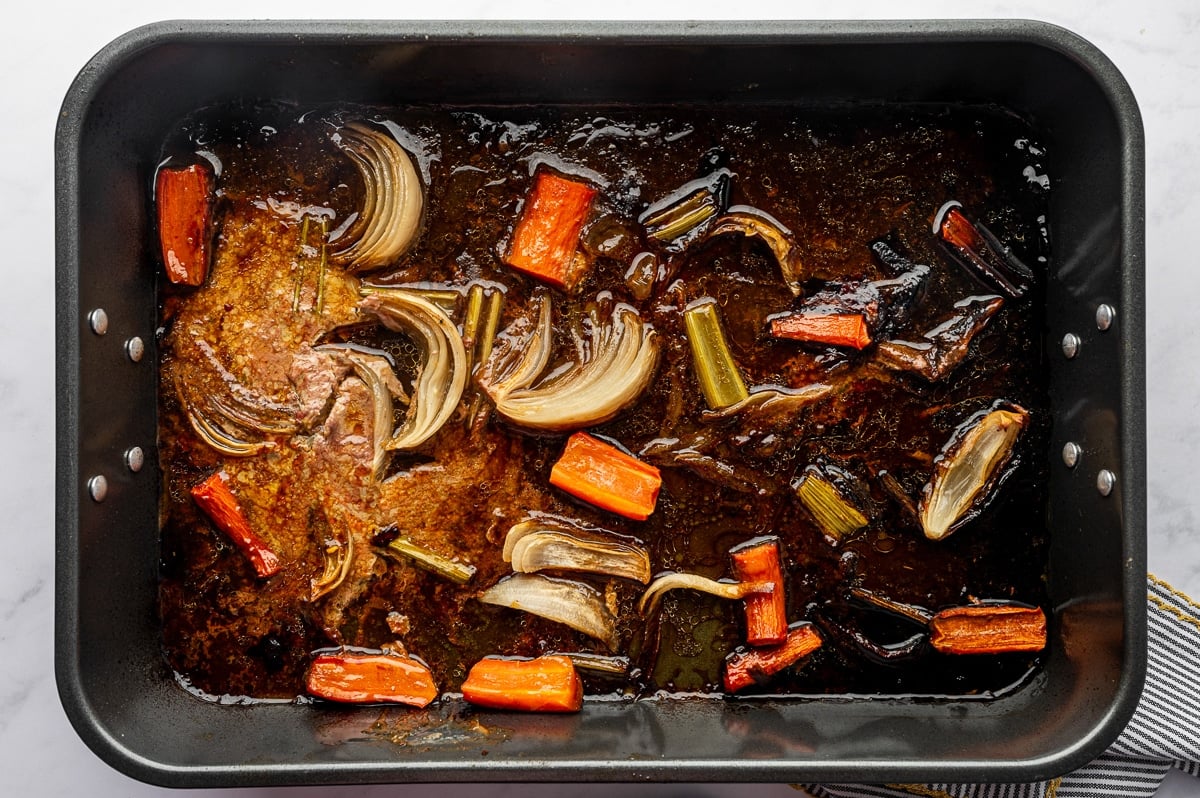
Step 3. Strain the drippings
Pour everything in the pan through a fine mesh strainer and into a heatproof measuring cup. Discard the solids left behind in the strainer.
Step 4: Separate the fat from the juices
Let the strained drippings sit for a few minutes – you’ll notice the fat naturally rise to the top. Use a spoon to remove the fatty top layer and set aside in a clean bowl.
Measure the remaining drippings left in the measuring cup. If you have less than 2 cups total liquid, add enough broth or giblet stock to reach 2 cups.
Step 5. Make the roux
Heat 3 tablespoons of fat over medium heat (if you don’t have enough turkey fat, supplement with melted butter or vegetable oil). Sprinkle with 3-4 tablespoons of flour and whisk until smooth. Let it cook for 2 to 3 minutes, or until lightly golden and it no longer smells like raw flour.

Step 6. Add the drippings and stock
VERY slowly pour the strained drippings into the roux, whisking constantly to prevent lumps. Add additional broth or giblet stock until the gravy reaches your preferred thickness. Simmer gently until smooth and velvety.
Helpful Tip: Always finish your gravy slightly thinner than you think you’ll want it. It will thicken as it cools in the gravy boat.

Season with salt and black pepper only if needed as the drippings already carry a lot of flavor.
Pro Tip: Make Extra Gravy
There is never enough gravy – especially when you’re feeding a crowd or planning for leftovers. If you’re roasting a smaller turkey, turkey breast, or simply didn’t end up with a lot of drippings, add extra turkey stock or giblet stock to stretch the yield without sacrificing flavor.
You can use the same approach to make extra gravy, too. Simply increase the flour and fat proportionally, then add more broth or giblet stock until the gravy reaches your desired consistency.
Storage and Reheating Tips
- To store: Transfer leftover gravy to an airtight container and refrigerate for 3 to 4 days. It will thicken as it chills which is totally normal.
- To freeze: Cool completely, then transfer to a freezer-safe container or bag and freeze for up to 3 months. I like to freeze in small portions for faster thawing and easier reheating.
- To reheat: Warm gently in a saucepan set over medium-low heat, whisking often. Add a splash of broth or water to loosen the texture if it becomes too thick.

How to Keep Gravy Warm
The easiest way to keep gravy warm is to transfer it to a small 2-Quart Crockpot set to warm. Stir occasionally and keep a little extra broth nearby to thin it if it starts to thicken. You can also pour hot gravy into insulated thermos to keep it hot, then transfer it back to a warm gravy boat right before serving. I’ve used this 40-ounce vacuum-insulated Thermos the past several years and it’s worked great.
Turkey Gravy Frequently Asked Questions
If your gravy turns lumpy, don’t panic. Strain it through a fine-mesh sieve or use an immersion blender to smooth it out. Whisking continuously while adding liquid slowly helps prevent lumps from forming.
Whisk in a little warm turkey stock, chicken broth, or even water, a little at a time, until it reaches a perfect pourable consistency.
Simmer it longer to reduce and concentrate the gravy. For a quicker fix, whisk 1 teaspoon of cornstarch with 2 teaspoons of cold water and stir that slurry into the simmering gravy until it thickens.
Absolutely. Use butter or oil in place of turkey fat and whisk in turkey broth or stock to make a roux-based gravy. You can also check out How to Make Gravy Without Drippings for more information
Absolutely. However, this version is made with pan drippings from your roasted turkey, so you’ll want to wait until the turkey is done to make it. If you need to make gravy ahead of time, try making my Homemade Gravy Recipe instead.
Gravy color varies depending on the drippings and how long you cook the roux. Darker roasted drippings, stronger seasonings, and a deeper brown roux will make a darker gravy with a more robust flavor. Lighter drippings and a lightly cooked roux results in a golden gravy that’s a bit milder. Both are totally normal and equally tasty.
More Popular Thanksgiving Recipes
If you make this Turkey Gravy recipe, I’d love to hear what you think! Please leave a comment and a star rating below, your feedback helps other readers discover (and enjoy) this recipe too. Thank you so much! 💛

Turkey Gravy Recipe (with Pan Drippings)
Ingredients
- 3 tablespoons fat, skimmed from pan drippings, or butter
- 3-4 tablespoons all-purpose flour, depending on desired thickness
- 2 cups strained turkey drippings, skimmed of fat
- giblet stock, broth, or water, as needed
- salt and pepper, to taste
Giblet Stock (optional)
- Turkey neck and giblets (exclude the liver)
- 4 cups water
- ½ onion, roughly chopped, optional
- 1 carrot, roughly chopped, optional
- 1 stalk celery, roughly chopped, optional
Instructions
- (Optional) Make the giblet stock. While the turkey roasts, place the neck and giblets (not the liver) in a small saucepan. Add approximately 4 cups water, ½ an onion, 1 carrot, and 1 celery stalk. Bring to a boil, then reduce to a simmer and cook for 45 to 60 minutes. Strain and discard the solids, reserving the liquid. This creates a flavorful backup if you don't have enough drippings.
- Separate the drippings. After roasting, carefully pour the drippings (the flavorful, fatty liquid left in the pan after cooking the turkey) through a fine-mesh strainer into a liquid measuring cup. Let the fat rise to the top, then use a spoon or ladle to carefully skim most of the fat from the top of the drippings. Set aside.
- Make the roux. Heat 3-4 tablespoons of reserved fat (or butter if you prefer) in a medium saucepan over medium heat. Whisk in 3-4 tablespoons of all-purpose flour. Cook for 2-3 minutes, or until golden and bubbly.
- Add drippings and stock. Slowly whisk in the strained turkey drippings, about ½ cup at a time. If needed, whisk in some of the prepared giblet stock (or water) until the gravy reaches your desired consistency.
- Simmer and season. Bring to a gentle simmer and cook for 5-7 minutes, stirring frequently, until smooth and thickened. Reduce the heat to low if the gravy starts to burn and add more stock or water, as needed. Season with salt and pepper, to taste.
Notes
- If you’re preparing the optional giblet stock, allow an additional 45 to 60 minutes (mostly hands-off) while the turkey cooks.
- Salt levels vary depending on whether the turkey is brined, how it is seasoned, and how much pan drippings are used. Always test your gravy before salting.
- If your gravy is too thick, whisk in a splash of warm broth or water until it reaches your desired consistency.
- If your gravy is too thin, simmer a bit longer to thicken, or whisk in a small cornstarch slurry (1 teaspoon cornstarch + 2 teaspoons cold water).
- Store leftover gravy in an airtight container in the refrigerator for 2 to 3 days
- Gluten-free adaptation: Swap regular flour with gluten-free 1:1 all-purpose flour.
Nutrition
Nutrition information is automatically calculated, so should only be used as an approximation.
